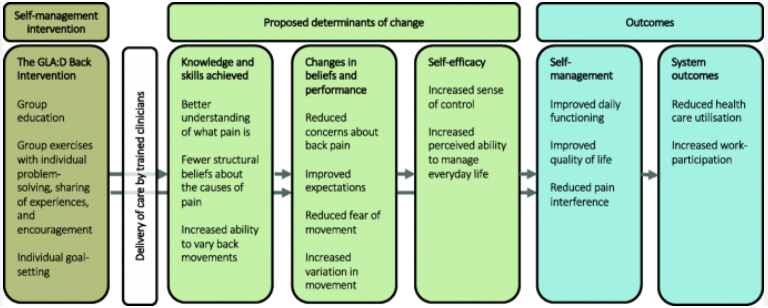Evaluation of a Back Pain Prevention Education Program for Transportation Workers
Main Article Content
Abstract
Background: In context, back pain refers to physical discomfort in the back. We classify aches in the back as upper-back, lower-back, or other types depending on which spinal region is afflicted. Depending on how long an episode of back pain lasts, we can classify it as acute, subacute, or chronic. Different people experience pain in different ways, such as a constant throb, sharp stabbing pains, or a burning sensation. Back pain can be caused by straining or twisting the back into an uncomfortable posture, or it can be the result of an injury to a spinal joint, ligament, or disc. The purpose of this research is to evaluate the efficiency of a proposed educational strategy for the prevention of back pain.
Material and Method: The same set of people were tested both before and after the intervention. Drivers in the transport unit of a tertiary care hospital in the Indian state of Maharashtra were surveyed to see how much they knew about back pain. The effectiveness of the planned education programme is evidenced by a rise in the percentage of workers successfully answering knowledge-related questions.After participating in a well-designed training programme, students' knowledge levels rose from 12 on the pretest to 83 on the posttest, a gain of 14.11 points.
Result: The p-value is significantly lower than 0.0001. The null hypothesis is rejected since the p value is less than 0.05.
Conclusion: To sum up, the results of this study indicate that the educational programme was an efficient means of raising driver-members' awareness of back pain prevention strategies.
Article Details
References
Stubbs B, Koyanagi A, Thompson T, Veronese N, Carvalho AF, Solomi M, Mugisha J, Schofield P, Cosco T, Wilson N, Vancampfort D. The epidemiology of back pain and its relationship with depression, psychosis, anxiety, sleep disturbances, and stress sensitivity: Data from 43 low-and middle-income countries. General hospital psychiatry. 2016 Nov 1;43:63-70.
Patel AT, Ogle AA. Diagnosis and management of acute low back pain. American family physician. 2000 Mar 15;61(6):1779-86.
Callaway WJ. Introduction to Radiologic Technology-E-Book. Elsevier Health Sciences; 2013 Aug 13.
Jewell NP, Lewnard JA, Jewell BL. Caution warranted: using the Institute for Health Metrics and Evaluation model for predicting the course of the COVID-19 pandemic. Annals of internal medicine. 2020 Aug 4;173(3):226-7.
Mahdavi SB, Riahi R, Vahdatpour B, Kelishadi R. Association between sedentary behavior and low back pain; A systematic review and meta-analysis. Health Promotion Perspectives. 2021;11(4):393.
Fink MR, Hjorte E, Wenger B, Cook FP, Cunningham M, Orf A. The impact of dry versus moist heat on peripheral catheter insertion in hematologic oncology patient. InOncol Nurs Forum 2009 Jul (Vol. 36, No. 4, pp. 1-11).
Shinde M, Anjum S. Educational Methods And Media For Teaching In Practice Of Nursing. Sneha Publication India (Dombivili). 2007.
Shinde M, Anjum S. Introduction to Research in nursing. Sneha Publication India (Dombivili). 2007
Potdar N, Shinde M B, Sadare S. Barriers to Comprehensive Care in Intensive Care Units. International Journal Of Science and Research. 2016;5(8):447-50.
Shinde MB, Hiremath P. Stressors, level of stress and coping mechanism adopted by undergraduate nursing students. International Journal of Nursing Education. 2014 Jul;6(2):231-3.
Mohite N, Shinde M, Gulavani A. Job satisfaction among nurses working at selected tertiary care hospitals. International Journal of Science and Research (IJSR). 2014;3(6).
Shinde MB, Mohite VR. A study to assess knowledge, attitude and practices of five moments of hand hygiene among nursing staff and students at a tertiary care hospital at Karad. Int J Sci Res. 2014;3(2):311-21.
Gulavani A, Shinde M. Occupational stress and job satisfaction among nurses. International Journal of Science and Research (IJSR). 2014 Apr;3(4):733-40.
Shinde M, Mane SP. Stressors and the coping strategies among patients undergoing hemodialysis. Int J Sci Res. 2014;3(2):266-76.
Shinde M, Anjum S. Effectiveness of demonstration regarding feeding of hemiplegia patient among caregivers. International Journal of Science and Research (IJSR). 2014;3(3):19-27.
Desai A, Shinde M, Mohite V. Knowledge of mental illness among caregivers of alcoholic’s. International Journal of Science and Research (IJSR). 2014;3(4):550-7.
Lenhardt R, Seybold T, Kimberger O, Stoiser B, Sessler DI. Local warming and insertion of peripheral venous cannulas: single blinded prospective randomised controlled trial and single blinded randomised crossover trial. Bmj. 2002 Aug 24;325(7361):409.
Cooksley T, Rose S, Holland M. A systematic approach to the unconscious patient. Clinical Medicine. 2018 Feb;18(1):88.
Horsting MW, Franken MD, Meulenbelt J, van Klei WA, de Lange DW. The etiology and outcome of non-traumatic coma in critical care: a systematic review. BMC anesthesiology. 2015 Dec;15(1):1-8.
Edlow JA, Rabinstein A, Traub SJ, Wijdicks EF. Diagnosis of reversible causes of coma. The Lancet. 2014 Dec 6;384(9959):2064-76.
Kelly CA, Upex A, Bateman DN. Comparison of consciousness level assessment in the poisoned patient using the alert/verbal/painful/unresponsive scale and the Glasgow Coma Scale. Annals of emergency medicine. 2004 Aug 1;44(2):108-13.

